Exploring the Impact of Edge Computing on Data Processing
With the data processing there are the explosion of IoT devices, AI applications, and real-time data analytics, traditional cloud computing is struggling to keep up with the increasing demand for speed and efficiency. In this case edge computing is emerging as a game-changer which reducing latency, and improving overall system performance.
Example: Instead of sending raw video footage to the cloud for facial recognition, edge devices can process the video locally and send only relevant insights.
Key Benefits of Edge Computing
Reduced Latency
Firstly by processing data closer to the source, edge computing enables real-time decision-making, critical for applications however, like self-driving cars and industrial automation.
Bandwidth Optimization
By sending only necessary data to the cloud reduces bandwidth consumption and associated costs.
Improved Security & Privacy
Since sensitive data is processed locally, the risk of exposure through data transmission is minimized.
Reliability & Offline Functionality
Edge devices can continue functioning even with limited or no internet connectivity, ensuring consistent performance.
Scalability
With edge computing, businesses can scale their operations efficiently without overloading centralized cloud infrastructure.
Impact on Data Processing
Faster Response Times: At this point real-time processing eliminates delays, making edge computing ideal for AI, AR/VR.
Distributed Computing: In the meantime, workloads are spread across multiple edge devices.
Efficient Resource Management: Similarly businesses can optimize computing power, storage, and network usage by processing data.
Use Cases of Edge Computing
Smart Cities – Traffic management, surveillance, and real-time analytics.
Healthcare – By using remote patient monitoring and AI-driven diagnostics.
Autonomous Vehicles – Instant decision-making for self-driving cars.
Manufacturing – Predictive maintenance and automated quality control.
Retail & E-commerce – Personalized shopping experiences and in-store analytics.
Final Thoughts
On the other hand edge computing is revolutionizing how data is processed, making systems faster, more efficient, and more secure.


